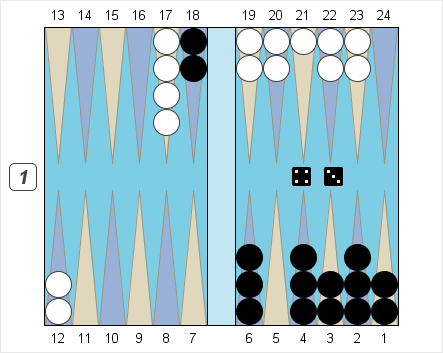
Black – Pips 80 (-14)
Black to Play 4-3
Black on roll. Black to play 4-3 in these situations:
(a) Tournament match, double match point.
(b) Money game, center cube.
(c) Money game, Black owns the cube.
In most positions, the correct play with a given roll is the same regardless of the position of the doubling cube. This isn’t always the case, however, and a good player needs to be alert to the situations where the position of the cube can determine the right checker play.
These positions tend to have a couple of salient characteristics:
> One of the possible checker plays will have the potential of swinging the position decisively, as opposed to some alternative play which will maintain the status quo.
> One play will result in a bunch of potential gammons, for one side or the other or even both, while the other play will resolve the game quietly, without a lot of gammons.
When these conditions occur, you may have a position where the cube location (and possible upcoming cube actions) needs to be taken into account. Now let’s look at our first position.
Black currently leads in the pip count by 14 (80-94). He’ll be up 21 after he plays his roll. His choices are between standing pat with 6/2 4/1, and running off the anchor now, while White has a blot in his board. Of the two running plays, 18/14 18/15, leaving 21 shots, trumps 18/11 with 24 shots.
At double match point, where no cube is in play, staying put with 6/2 4/1 is very slightly better than running. In general, when the choice is not clear-cut, you should be reluctant to volunteer decisive shots in a cubeless game. The problem is that when the shots are missed, you don’t have a cube to double your opponent out. This means that you’ll leave a few more shots on the second turn that you could have avoided with an accessible cube.
With a live cube, the cube position often helps determine the right play. If the cube is centered in this position, then running favors Black. Take a look at the resulting position:

Black – Pips 73 (-21)
Position A: Black has played 18/14 18/15.
If Black runs with both checkers and White misses (say with a roll like 4-1), Black has a very efficient double, with winning chances in the low 70s. If Black runs, White hits, and Black fans, White then has a very inefficient cube. (After a typical sequence like White 53: 13/10*/5, Black fans, White’s winning chances are in the mid-80s and Black has a monster pass.) Efficient cubes are more profitable cubes, so if the plays were close in a cubeless game, the efficiency of the resulting cubes argues for the running play with a centered cube, and that is indeed the correct choice.
If Black owns the cube in a money game his gammon losses are activated, which they weren’t when the cube was centered. (It was almost impossible then for him to be doubled into a position where he had a significant chance of being gammoned.) Running two men leads to far more gammon losses than staying put, so as in the cubeless game 6/2 4/1 is right.





